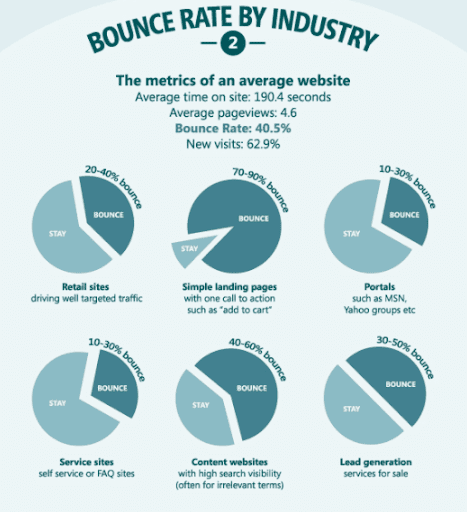Without a doubt, marketing has changed from its traditional characteristics of radio ads, billboards, and flyers targeting the end user with a product or service to more creative methods, including content marketing. However, for most companies, content marketing is still a new beast so having a few content marketing metrics to track what is working and what is not is imperative. It will help your company use resources where they are giving the best returns.
The right metrics will serve as standards of measurement to help your company understand what strategies to keep and when it is time to get back to the drawing board and re-strategize.
The key here is to not get overwhelmed by tons of KPIs but rather to narrow down on a few content marketing metrics that are important to your goals.
This article should serve as a good introduction to different metrics you might want to consider tracking depending on your company’s long-term goals.

Here’s our list of the content marketing metrics worth tracking:
Front and Center Metrics: Social Media
Behind the Scenes Metrics: Website and Content
Invisible Metrics: Lead Generation

What Are the Goals and Purposes of Content Marketing Metrics?
You can pop out content all day long and think everything is fine and dandy and the outcome is worth all your hard work. But is it? When you implement attainable ways to measure your content marketing success, you can clearly see whether your strategies are successful.
In a Semrush survey, only 57% of companies said they have a documented content marketing strategy. This means almost 43% of companies are not tracking their metrics, implying they don’t know how well they are doing.
Since content marketing aims to reach clientele by producing great content, content creators must know how valuable their content is.
Content Marketing Metrics Worth Tracking
Let’s say you spent 2 hours writing a blog post, another hour adding images, and another hour editing and posting to your blog. Great! Success! Or so you might think. Without actually tracking how your post does, you honestly do not have any idea how well the post did.
Enter content marketing metrics you should be tracking. In this article, we will take a look at the best metrics you should be aware of and how to benefit from them while tracking.
Front and Center Metrics: Social Media
Social media is one of the most common ways to measure content marketing success. On apps such as Facebook, Instagram, Twitter, and Tiktok, success is publicly shown through likes and follows, comments, and interactions with posts.
Facebook is found to be the most popular social media platform across all age groups. If you are not sure how to engage new customers through social media platforms, take a look at Get Talkative’s How To on engaging customers online. Business Insurance also shares some great resources on using Facebook to turbocharge your business.
Once you have implemented methods to use social media effectively in your content marketing, track your success. Take screenshots of your metrics every week so you can go back and see your growth. Look into posts that did better than others and see how to implement the same strategies with other posts.
Whatever you decide to do on social media, just make sure you track your success and failures so you know where to focus.

Behind the Scenes Metrics: Website and Content
A website can look spectacular from the outside. It may be user-friendly, has excellent color schematics, and has some great tools and articles, but is it really doing as well as it may appear? The only way to find out is by tracking the metrics of everything feeding into the website.
Below we will look into several aspects of website and content management and what you should track.
1. Time Spent Creating Content
A survey by Statista found that 27% of content creators spent 5 to 10 hours every week on content creation, and less than 10% spent 20 to 40 hours per week.
Remember the blog post you might think you spent 4 hours putting together? Imagine if there was an easier way to create excellent content without spending so much time on content creation. Well, thankfully, there is.
Narrato’s AI Content Assistant is an outstanding tool for content planning and creation. It will help you create and edit content faster with the contextual grammar checker tool, and detect structuring issues like long paragraphs and redundant words. The grammar and readability tool supports over 50 languages. You also get readability scores and improvement suggestions as you are writing. It has an automated SEO content brief generator that helps speed up content optimization for search. It has an AI writer to create content for multiple use cases and an AI topic generator to accelerate content planning and creation.

This platform will certainly reduce time spent creating content and allow you to focus on other marketing efforts.
Additionally, if you want to free yourself of the content creation bit to focus on other parts of the business, Narrato Marketplace can connect you with the best freelance writers with relevant experience. You will get great quality, fast turnarounds, and quick revisions, so you can put out more content than you have ever been able to.

Keep track of how much time you spend creating and editing content and hiring others. Using a reliable time monitoring app can help streamline this process by providing insights into how your time is allocated across different tasks. The metrics speak for themselves, and you are certain to feel relieved with additional time to focus on other aspects of the business.

2. Click Through Rate (CTR)
A CTR is the ratio of the number of clicks on a specific link or calls to action and the number of times people were exposed to the link.
For instance, if your number of clicks is 6 and you have 100 impressions, your CTR would be 6%.
Good click-through rates vary by industry, so you should find an average CTR for your industry and track how well you are doing and where you should focus on improving.
3. Bounce Rate
A bounce rate is the percentage of visitors that leave a webpage without taking action. Examples of action include clicking on a link or another page, making a purchase, filling out an e-mail form and signing up for services. Basically, a bounce rate is someone who visits one page on your website and then bounces off to another.
The lower your bounce rate, the better because you want to keep readers and customers on your website as long as possible. Semrush states that an optimal bounce rate would be in the 26% to 40% range.
If you see that you have a high bounce rate, this is an excellent opportunity for improvement as you look into what is causing the high rate. Simple things such as too many ads and content not relatable to your niche are easy-to-fix issues that could quickly improve your bounce rate.
4. Traffic
If you have a website, you definitely want to be tracking traffic to your site. Google Analytics is an easy free tool to measure website traffic. This metric is essential for showing your growth and success as you improve your content marketing strategies.
5. Ranking Keywords
Keyword ranking is where your place ranks in search results pages for specific search words. For example, when a reader types a search term into Google that relates to your website, the spot your URL appears is your keyword ranking.
More than 50% of marketers agree that keyword rankings and organic traffic are the top metrics they use to measure the success of their content-led SEO strategies.
Suppose you want to delve into how to use keyword ranking. In that case, Narrato shares 30 SEO Content Planning success secrets from marketers, including how to benefit from keyword ranking, and Serpmaniac provides great insight on what to look for when tracking ranking keywords. Additionally, Lawrank gives some specific examples of using ranking keywords.
Understandably, ranking keywords is a metric you should be tracking and focusing on as it will give your website more visibility and attract more readers and customers.
Invisible Metrics: Lead Generation
Content marketing intends to raise awareness and, potentially, create income. Lead generation is an “invisible metric” that is essential to track for success. It is considered invisible because it is not clearly shown on analytics and is harder to find in programs or websites.
However, knowing how many of your readers or customers turn into leads is greatly relevant to positive content marketing outcomes.
1. Form and Email Submission

Create a free tool or booklet on your website where users must input their emails to receive it. Capturing more emails will allow you to communicate more with customers through newsletters and expertly written emails.
Studies show that email visitors are the most likely to convert on forms, and people from search advertisements are the least likely. If sending out bulk emails unnerves you, use Sendinblue’s bulk email service to mass-send awesome information to your readers.
They have tons of templates and features that allow you to really level up with your emails.
2. Marketing Qualified Leads
You should be able to track Marketing Qualified Leads through a CRM program. This lead is defined as a customer who has shown interest in your brand. This often means that the potential customer has engaged with you and your website by signing up for emails, placing products in their online cart, or consistently visiting your website.
An important part of lead generation is knowing what these customers are up to so you may focus on how to turn them from a lead into a customer.
Implement Effective Lead Management
Once you know that you have leads, do not let them fall through the cracks and lose track of them. Instead, use workflow automation tools like a WhatsApp CRM to improve your Customer Relations Program and ensure you follow up with potential customers.
Examples of reaching these leads could be something as simple as an e-mail reminder for items in their online cart to enticing e-mails about what your brand can offer them. Regardless of the method, you must find a way to follow up with these leads.
Final Recommendations for Content Marketing Metrics
As we saw above, there are many ways to track metrics for content marketing. As a general rule, the more visible the metric, the less important it probably is.
For example, a post with 2,050 shares means nothing if it is not generating traffic to your website. It is still important to track overall, but your efforts should be focused on the less visible metrics of traffic to your website and how to turn a lead to your website into a customer.
Tracking your content marketing metrics will allow you to see which areas you should invest your resources in your content workflow. For example, should you spend less time writing posts and more time optimizing existing content for search? Knowing the possibilities will help you narrow down what improvements you can make in your content creation process and improve your content processes overall.
81% of marketers see content as a core strategy in their business. Be a step ahead of everyone else and keep track of your content strategy metrics. Know your strengths and work on your weaknesses.
Keep in mind that tracking your metrics is a long-term commitment. Changes do not always become readily apparent in a month or two. Often the growth is slow and steady, so consistently tracking will show how you have grown over time.

Freya is an SEO consultant who helps brands scale their organic traffic with content creation and distribution. She is a quoted contributor in several online publications including Business Insider, Fox Business, Yahoo Finance, and the Huffington Post. She also owns CollectingCents- a personal finance blog that she grew from the ground up. You can reach out to her at freya@collectingcents.com









